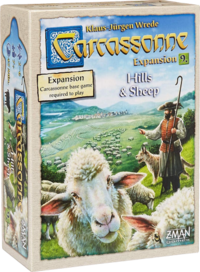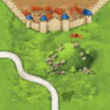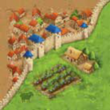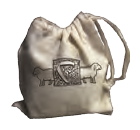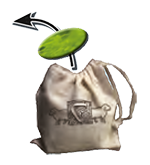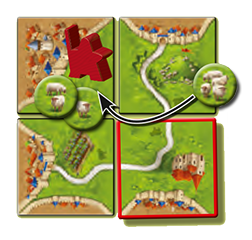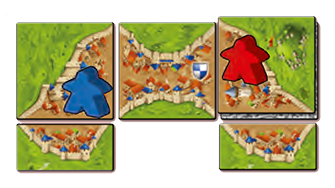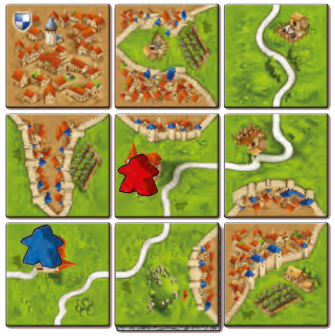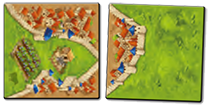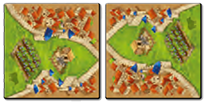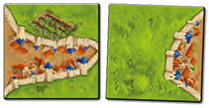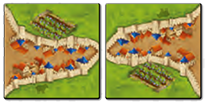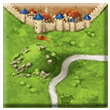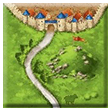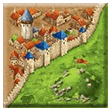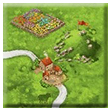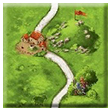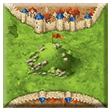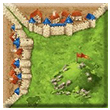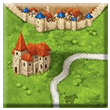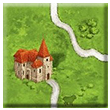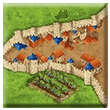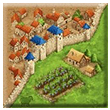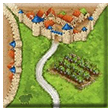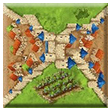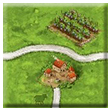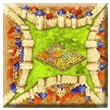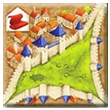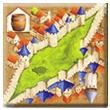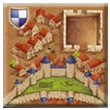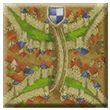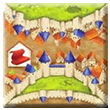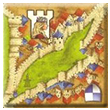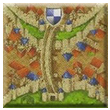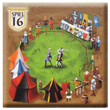Hills & Sheep
 |
You are reading the rules for this tile design. |
 | Read the following rules if your tiles look like this. |
| If your tiles have a different design, then choose a game from Spin-offs. |  |
The Shepherds in the meadows throughout Carcassonne wait peacefully until their entire flock of sheep gathers around. However, they have to be careful that a wolf doesn’t show up before they have led their flock safely into the stable. In the hills, you can take control of lands once thought lost. In addition, many a monk is always happy to have a vineyard near his monastery.
General info and comments

Hills & Sheep was released for the new edition by Hans im Glück in 2018.
This expansion was originally released for the 1st Edition, known as C1 for short, in 2014.
This is the ninth major expansion for Carcassonne and introduces some new aspects to the game.
New features/elements:
- Shepherds, a special figure that can grow and score a flock of sheep.
- Sheep and wolf tokens, that are drawn from a bag to add new sheep to your flock or lose it if you draw a wolf.
- Vineyards, that provide additional points to neighboring monasteries
- Hills, that may break ties in a feature being scored
Contents
- 18 land tiles
- 18 flock and wolf tokens (4x 1 sheep, 5x 2 sheep, 5x 3 sheep, 2x 4 sheep, 2x wolf)
- 1 cloth bag
- 6 shepherds, 1 in each 6 colors
Rules
Preparation
Place all of the sheep and wolf tokens in the bag. Give each player (including yourself) the shepherd in their color. Shuffle the new tiles with the other land tiles.
With the exception of the new rules used with this expansion, all basic Carcassonne rules remain unchanged.
Shepherd, sheep and wolves
2. Placing a meeple
After placing a tile with a field, you may choose to either place a meeple as normal or place your shepherd on the field. If you place the shepherd, immediately draw a token from the bag.
If it is a sheep token, place it sheep-side up next to your shepherd in the field.
If it is a wolf token, place it back in the bag and return your shepherd to your supply.
You can place your shepherd even if there is already a farmer in that field (and vice versa), but you cannot place a shepherd if there is already another shepherd in that field. The shepherd is a special figure, not a meeple.
During the game, the shepherd has the following effects:
1. Placing a tile
When you place a tile to expand your shepherd's field, first resolve the action 2. Placing a meeple as normal, then resolve one of the following two actions:
- Grow the flock (draw another token from the bag)
- Guide the flock to the stable (score the sheep)
Grow the Flock
Draw a token from the bag:
Guide the Flock to the Stable
For each sheep token in the field with your shepherd, score points equal to the number of sheep shown on the token. Then, return all of those sheep tokens to the bag and return your shepherd to your supply.
Multiple Shepherds on One Field
If separate fields with shepherds are later connected, multiple shepherds can be in the same field. All players with shepherds in that field can grow their flock or guide their flock to the stable as normal, but those actions can resolve differently:
- When a sheep token is drawn, the token is placed as normal. When a wolf token is drawn, all sheep tokens from that field are returned to the bag, and each shepherd on that field is returned to its owner's supply.
- When a player guides a flock to the stable, all sheep tokens from that field are returned to the bag, and all players with shepherds on that field score points for all of the sheep tokens in that field.
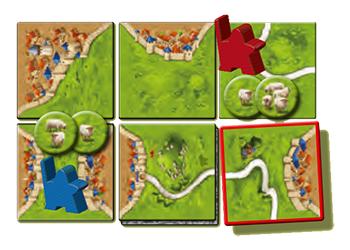
If you had chosen to grow the flock instead and had drawn a wolf token, all shepherds and all of the sheep in that field would be returned to the bag, and no one would score any points.
Normally to score points for your sheep, you must use the Guide the flock to the stable action.
Exception: If any player closes a field with shepherds and sheep by fully surrounding it by roads and cities, immediately resolve the Guide the flock to the stable action for that field. [1] [2]
3. Scoring a feature
The shepherd does not score for any other features and is not affected by any other scoring.
Final Scoring
If your shepherd and sheep are in a field at the end of the game, you do not score any points for them.
Hills
(Idea: Manfred Keller)
1. Placing a tile
If you draw a tile with a hill, immediately take another facedown tile and place it under the hill tile. Do not look at the second tile! Place the hill tile using normal placement rules but keep the facedown tile under it. [3]
2. Placing a meeple
After placing the hill tile, you may place a meeple on the tile as normal (on one of the features: road, city, field). You cannot place a meeple directly on the hill itself.
3. Scoring a hill
If you have a meeple on a feature of a hill tile, ties for scoring that feature are broken in your favor. When a feature is scored (road, city, and field), if players are tied for most meeples, check to see if any part of that feature appears on a hill tile. If it does, and if one of the tied players has a meeple on that feature of the hill tile, that player breaks the tie and is the only player who scores points for that feature. Unlike ties without hills, other tied players do not score any points. [4] [5]
Having a meeple on a hill only affects ties when scoring a feature. If there is not a tie, the hill provides no additional effect. After a feature is scored, a meeple on a hill tile is returned to its owner's supply as normal.
Final Scoring
Meeples on hill tiles break ties and score points as normal during final scoring (including farmers).
Vineyards
1. Placing a tile
You place a tile with a vineyard as normal.
2. Placing a meeple
After placing the vineyard tile, you may place a meeple on the tile as normal, but you cannot place the meeple directly on the vineyard itself.
3. Scoring a vineyard
When completing and scoring a monastery, the player who scores points for the monastery scores 3 additional points for each vineyard on one of the 8 surrounding tiles. A single vineyard can score additional points for multiple monasteries.
Final Scoring
During final scoring, an incomplete monastery does not score additional points for the surrounding vineyards. [6]
New land tiles
New Special City Tiles (Idea: Jan König)
Note: If you place these two tiles next to each other as shown, all of the separate city segments are connected. (The segments of the two tiles are intentionally offset.)
Note: If you place these two tiles next to each other as shown, the two city segments are not connected. The top and bottom fields are also not connected.
Other expansions
This section contains additional information about the interactions with other Carcassonne expansions.
![]() The following figures can share a field with your shepherd without any effect on either figure:
The following figures can share a field with your shepherd without any effect on either figure:
![]() Exp. 3 - The Princess & the Dragon
Exp. 3 - The Princess & the Dragon
![]() The dragon will eat only the shepherd (and that shepherd's flock) on its tile. It will not eat other shepherds from the same field unless it moves onto the corresponding tile. The shepherd is not a meeple, so the fairy cannot be assigned to it.
The dragon will eat only the shepherd (and that shepherd's flock) on its tile. It will not eat other shepherds from the same field unless it moves onto the corresponding tile. The shepherd is not a meeple, so the fairy cannot be assigned to it.
![]() You cannot capture a shepherd with a tower.
You cannot capture a shepherd with a tower.
![]() You cannot place your shepherd into the city of Carcassonne.
You cannot place your shepherd into the city of Carcassonne.
![]() The following figures can use the hill's tiebreaking effect:
The following figures can use the hill's tiebreaking effect:
- Normal meeple (
 Base Game)
Base Game) - Abbot (Base Game -
 The Abbot) - useful for the Darmstadt Church bonus
The Abbot) - useful for the Darmstadt Church bonus - Large meeple (
 Exp. 1 - Inns & Cathedrals)
Exp. 1 - Inns & Cathedrals) - Wagon (
 Exp. 5 - Abbey & Mayor)
Exp. 5 - Abbey & Mayor) - Mayor, if there is a coat of arms in the city (
 Exp. 5 - Abbey & Mayor)
Exp. 5 - Abbey & Mayor) - Meeple on a bridge that is on a hill tile (
 Exp. 8 - Bridges, Castles & Bazaars)
Exp. 8 - Bridges, Castles & Bazaars) - Ringmaster (
 Exp. 10 - Under the Big Top)
Exp. 10 - Under the Big Top) - Guard meeple (
 Exp. 11 - Ghosts, Castles & Cemeteries)
Exp. 11 - Ghosts, Castles & Cemeteries) - Phantom (
 The Phantom)
The Phantom)
Note: A tie in majority is not defined by the number of meeples on a feature, but by the total strength of the meeples on it. The strength of the meeple placed on the hill is irrelevant in a tiebreak (it could be a mayor with strength 0).
![]() You cannot place an abbey tile under a hill tile. A hill can be part of the tile junction that the barn is placed on, but there is no additional effect.
You cannot place an abbey tile under a hill tile. A hill can be part of the tile junction that the barn is placed on, but there is no additional effect.
![]() You may deploy a meeple from from the city of Carcassonne on a hill tile with a feature about to be evaluated. [7] If you do, you gain the benefit of the hill.
You may deploy a meeple from from the city of Carcassonne on a hill tile with a feature about to be evaluated. [7] If you do, you gain the benefit of the hill.
![]() Exp. 8 - Bridges, Castles & Bazaars
Exp. 8 - Bridges, Castles & Bazaars
![]() You can place a bridge on a hill tile. You can place a castle (even partially) on a hill tile. If you take a hill tile during a bazaar auction, do not take the facedown tile (to put under the hill) until it is your turn to place the hill tile.
You can place a bridge on a hill tile. You can place a castle (even partially) on a hill tile. If you take a hill tile during a bazaar auction, do not take the facedown tile (to put under the hill) until it is your turn to place the hill tile.
![]() The following figures can use the effect of the vineyard when scoring a monastery:
The following figures can use the effect of the vineyard when scoring a monastery:
![]() Abbeys can score additional points for vineyards.
Abbeys can score additional points for vineyards.
![]() Shrines can score additional points for vineyards. If there is a challenge, you score the additional points only if you win the challenge.
Shrines can score additional points for vineyards. If there is a challenge, you score the additional points only if you win the challenge.
![]() Exp. 8 - Bridges, Castles & Bazaars
Exp. 8 - Bridges, Castles & Bazaars
![]() You can place a bridge on a vineyard tile.
You can place a bridge on a vineyard tile.
![]() Monasteries in Germany /
Monasteries in Germany / ![]() Monasteries in the Netherlands & Belgium /
Monasteries in the Netherlands & Belgium / ![]() Japanese Buildings
Japanese Buildings
![]() When using German monasteries or Japanese buildings, the vineyard bonus is applied if the meeple is placed as a monk and the feature is scored as a finished monastery. However, the vineyard bonus is not applied if a meeple is placed as an abbot, as the abbot scores only at the end of the game, when the vineyard has no effect.
When using German monasteries or Japanese buildings, the vineyard bonus is applied if the meeple is placed as a monk and the feature is scored as a finished monastery. However, the vineyard bonus is not applied if a meeple is placed as an abbot, as the abbot scores only at the end of the game, when the vineyard has no effect.
House rules
![]() If you’re not concerned about whether or not players count tiles as a strategy, and you want to be able to use all of the tiles in the game, you can place blank tiles under any hills that are drawn. (Thanks to Crispy Jones.)
If you’re not concerned about whether or not players count tiles as a strategy, and you want to be able to use all of the tiles in the game, you can place blank tiles under any hills that are drawn. (Thanks to Crispy Jones.)
Tile distribution
Footnotes
For Icons explanation and licensing please visit Icons page.
- ↑
 This exception refers to a special case when a field is surrounded and "closed" with roads and cities so it cannot expand anymore. At that point the shepherd scoring takes place: The player gets points for the sheep, the sheep go back into the bag, and the shepherd goes back to the player's supply. (12/2015)
This exception refers to a special case when a field is surrounded and "closed" with roads and cities so it cannot expand anymore. At that point the shepherd scoring takes place: The player gets points for the sheep, the sheep go back into the bag, and the shepherd goes back to the player's supply. (12/2015)
A field completely surrounded without any gaps cannot be extended, but this does not mean that the field is scored automatically. The surrounded field will be scored at the end of the game as usual. - ↑
 The same exception should apply when placing a shepherd on an inner field. Inner fields are present on several CCCC or CCCF tiles, so they closed by city walls and cannot be extended. In this case, you would place the shepherd on the inner field, perform the Grow the flock action and, if no wolf token was drawn, you would perform the Guide the flock action automatically since the filed is already closed. These are examples of CCCC tiles with inner fields:
The same exception should apply when placing a shepherd on an inner field. Inner fields are present on several CCCC or CCCF tiles, so they closed by city walls and cannot be extended. In this case, you would place the shepherd on the inner field, perform the Grow the flock action and, if no wolf token was drawn, you would perform the Guide the flock action automatically since the filed is already closed. These are examples of CCCC tiles with inner fields:
These are examples of CCCF tiles with inner fields:
The following CCCC tile doesn't show an inner field as it is not surrounded by walls or roads as a regular field. The green patch serves just as a decoration for a jousting scene. (In any case, it would be rather odd to have shepherds and flocks around knights in a jousting tournament, right?)
- ↑
 If the hill tile drawn is the last tile in the game, the player is still allowed to place it without a second tile underneath. The normal turn (move wood, score features) then takes place. Note that generally a tie break would not be possible with this tile – even if a meeple is placed on it, there will be no way to connect that meeple to an occupied feature, as the game will be over. (10/2014)
If the hill tile drawn is the last tile in the game, the player is still allowed to place it without a second tile underneath. The normal turn (move wood, score features) then takes place. Note that generally a tie break would not be possible with this tile – even if a meeple is placed on it, there will be no way to connect that meeple to an occupied feature, as the game will be over. (10/2014)
- ↑
 If the tied players also have equal numbers of meeples on hills in that feature, the tie remains unbroken and both players still receive the points. Even if the number of meeples on hills is unequal, as long as each of the tied players has at least one meeple on a hill, the tie is unbroken and both players receive the points. (5/2014)
If the tied players also have equal numbers of meeples on hills in that feature, the tie remains unbroken and both players still receive the points. Even if the number of meeples on hills is unequal, as long as each of the tied players has at least one meeple on a hill, the tie is unbroken and both players receive the points. (5/2014)
- ↑
 As an alternative tiebreaker method, the number of meeples on hills can be counted. Thus, if two players have the same number of meeples in a feature, but one player has more of those meeples on hills than the other player does, the player with the most meeples on hills gets all of the points and the other player gets none. (5/2014)
As an alternative tiebreaker method, the number of meeples on hills can be counted. Thus, if two players have the same number of meeples in a feature, but one player has more of those meeples on hills than the other player does, the player with the most meeples on hills gets all of the points and the other player gets none. (5/2014)
- ↑
 Regardless of the type of monastery involved (normal cloister, abbey, shrine, German monastery or Japanese building), the vineyard has no effect on final scoring at the end of the game. (5/2014)
Regardless of the type of monastery involved (normal cloister, abbey, shrine, German monastery or Japanese building), the vineyard has no effect on final scoring at the end of the game. (5/2014)
- ↑
 We updated this sentence according to the the German rules. The rules by ZMG contain a mistranslated version of this sentence: "You can place one meeple from the city of Carcassonne on a hill tile with a feature that has not been completed."
We updated this sentence according to the the German rules. The rules by ZMG contain a mistranslated version of this sentence: "You can place one meeple from the city of Carcassonne on a hill tile with a feature that has not been completed."
- ↑
 If an abbot is removed from an uncompleted monastery in phase 2. Placing a meeple, it will not get points for any adjacent vineyards. Since you are scoring the meeple and not the feature, vineyards do not apply in this case.
If an abbot is removed from an uncompleted monastery in phase 2. Placing a meeple, it will not get points for any adjacent vineyards. Since you are scoring the meeple and not the feature, vineyards do not apply in this case.
- ↑
 We updated the wording to make it closer on the German rules and avoid the ambiguity that affected the removal of the abbot when the monastery was completed. The original English wording is: "Your abbot can score additional points for vineyards only if the monastery is completed. If you return the abbot before the monastery is completed, you do not score the additional points."
We updated the wording to make it closer on the German rules and avoid the ambiguity that affected the removal of the abbot when the monastery was completed. The original English wording is: "Your abbot can score additional points for vineyards only if the monastery is completed. If you return the abbot before the monastery is completed, you do not score the additional points."
